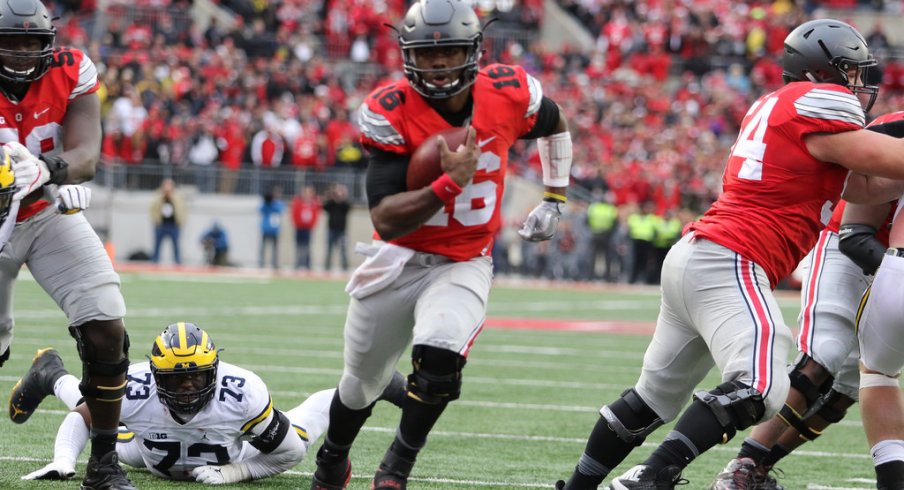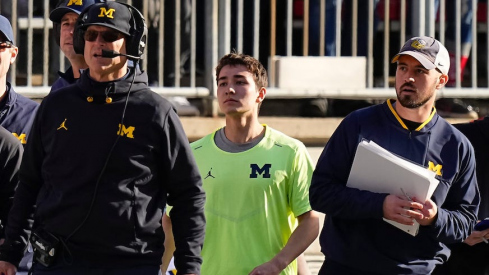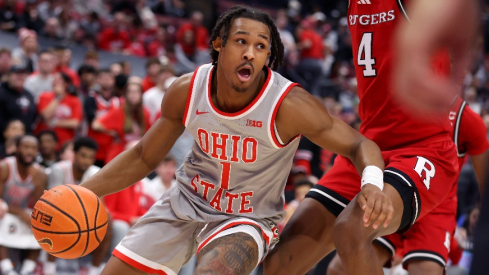In a game to be remembered for years, the Ohio State offense nearly put on a performance to forget.
With so many pivotal moments to look back on from the 2016 edition of The Game, one can't be blamed for failing to recall the Buckeyes' strong opening drive. Though it ended with a missed field goal, all the familiar faces emerged to pick up big chunks of yardage against the vaunted Wolverine defense on the opening possession.
Curtis Samuel ran for 16 yards while Mike Weber added six of his own. Noah Brown caught one pass for 15 yards and drew a holding penalty on a big third down to keep the drive alive.
But the biggest takeaway from that first drive was the effectiveness with which J.T. Barrett ran the football. The junior QB ran twice for 25 yards, both times reading a Michigan defender before keeping the ball for himself, just as he had in last year's big win in Ann Arbor.
Although that opening effort seemed all for naught as Tyler Durbin pushed a 37-yard field goal wide, it laid the seeds for what was to come later in the afternoon. But before that fruit could come to bear for coordinators Ed Warinner and Tim Beck, the Buckeyes would struggle to execute the entirety of their game plan.
The duo of Ohio State play-callers would make an effort to get the ball to their playmakers, specifically Curtis Samuel, in new ways throughout the first half. Often, those wrinkles were relatively small, looking instead to create more favorable matchups than introduce new concepts entirely.
One such way was to keep Samuel, the team's best receiver, lined up in the backfield as though he was going to block on a long third down passing play in the second quarter. As they would for the majority of the day, the Michigan defense played man-to-man pass defense (often Cover 1, but also mixing in Cover 0 and Cover 2-Man, as seen below). In this specific scenario, that meant an inside linebacker would be responsible for Samuel in coverage.
After some contact at the line, Samuel easily squirts past the linebacker, Mike McCray, with no other defender within 15 yards of him. Had Barrett been given the time to make a decent throw, Samuel should've easily picked up a first down and more. Instead, the Buckeyes were forced to trot out Cameron Johnston for one of his six punts on the next play.
But providing Barrett time to throw became the biggest concern for the entire offense, as the Michigan defensive line consistently brought extra rushers. Though seven Wolverines were responsible for the eight sacks that afternoon, no player was more unstoppable than senior defensive end Taco Charlton.
Charlton saved his best for last, tallying a career-high 2.5 sacks in his final regular season contest as a Wolverine. Although Isaiah Prince and the rest of the Ohio State offensive line won't have to see him ever again in a winged helmet, they'll undoubtedly be seeing him in their nightmares, as he attacked the Buckeye pocket from all angles this afternoon.
Nearly every starter up front for the Buckeyes had a rough afternoon in pass protection, save left tackle Jamarco Jones, as Barrett was pressured on over 50% of his passing attempts. That pressure eventually forced Barrett into some bad habits, failing to step into his throws, resulting in a long stretch during the second and third quarters in which he missed a number of open receivers.
“First half we had good things called. We just weren't executing it, whether it myself, O-line, receivers, it was everybody played their part in that,” Barrett said after the game. “The second half, defense was doing their job. We've gotta do ours. So let's go out there and do our part. We were doing everything we prepared for. So it was just really going out and executing that.”
Protection issues aside, the game plan put together by Warinner and Beck was a solid one, attacking the weaknesses of Michigan's man coverage. Most notably, the duo began to consistently flare out Weber or Samuel from the running back spot, acting as a magnet for the Wolverine inside linebackers and opening up the middle of the field.
Not only would the inside linebackers peel outside to stop some kind of swing pass to the Buckeyes' best playmakers, but hyper-aggressive space defenders like Jabrill Peppers were late getting to their own assignments as that motion came their way. Though tight end Marcus Baugh is clearly not faster than Peppers, he was able to gain inside position like a basketball player posting up and catch an easy drag route against him in coverage, thanks to the slight hesitation caused by Weber's pre-snap motion out wide.
While the Wolverines' biggest defensive wrinkle was the occasional 'odd' defensive front, playing three down linemen with one acting as a true nose guard over the center while usually blitzing one or both inside linebackers behind it, the Buckeyes had a clear counter for it. As Michigan attacked interior gaps, Barrett and company went right at Charlton as he looked to create havoc in the backfield.
The Buckeyes began to build some rhythm running the ball once they called for this tight zone-read concept with Weber running inside and Barrett attacking the edge. Meanwhile, the Wolverines were finally on their heels, no longer prepared for whatever came their way.
One of the biggest weaknesses of man coverage is the constant desire to match up defenders to the proper skill set of the receivers. Cornerbacks like to be on receivers while safeties and linebackers prefer backs or tight ends. If you add in the additional wrinkle of putting one specific corner on a specific receiver, such as Jourdan Lewis on Curtis Samuel, then the entire unit has to shake out their assignments as needed once that matchup is set.
Such confusion led to the play that truly jump-started the Buckeyes' comeback effort.
With constant pressure in his face, Barrett began looking for running lanes after one or two quick pass reads. If he couldn't get the ball out quickly, he would instead look to use his legs to pick up positive yardage.
Early in the fourth quarter, though, the Wolverines' confusion while lining up to defend an empty formation would lead to Barrett's best decision of the day. Both linebackers had vacated the middle of the field to cover receivers wide, leaving the Buckeyes with five blockers against only four defenders within 15 yards of the ball. Though his receivers still ran their routes, Barrett immediately took off upfield, signaling center Pat Elflein to lead him.
NFL teams call for 'Cover 1' all the time, as it's effective at reading the eyes of pocket passers, but it can be exposed by running quarterbacks that don't have anyone near the line to account for them outside of the pocket. As has often been the case with Barrett, this 41-yard run gave him the confidence to begin throwing the ball with better precision as well, knowing he could change the arithmetic on the field by using his legs.
| Comp | att | Comp % | YArds | |
|---|---|---|---|---|
| Before 41-yard rush | 9 | 24 | 37.5% | 57 |
| After 41-yard rush | 6 | 8 | 75% | 67 |
On the next drive, just before tying the game on a last-second field goal, the Buckeyes caught the defense off guard again as they looked to account for Barrett in the run game, leaving only two defenders out wide to cover three receivers. Immediately after taking the snap, the QB found a big, open target in Noah Brown for yet another first down.
By the time overtime began, momentum had swung firmly back in favor of the Buckeyes. Not only had the offensive line finally begun to find some rhythm, the play-callers knew exactly how to use the Wolverines' aggressive tactics against them.
At left tackle, Jones had become the most reliable blocker to run behind, and the decision to spot the ball on the right hashmark to open the possession was obviously by design. By placing the tight end to the right, the defense's 'over' front would create an easy read for Barrett on the speed option to Samuel as Jones seals off the linebacker to that side.
After Samuel gashed the defense for 18 yards, the Wolverine linebackers seemed determined to keep him from doing the same on the next play. But the Buckeyes called a wonderful constraint to their first snap in overtime, flipping the same formation and appearing to call another speed option to the wide side of the field, but this time with left guard Michael Jordan pulling around to create a 'Power-O' concept for Barrett to keep the ball and run untouched into the end zone.
With the Buckeye offense now attacking in every direction, the Michigan linebackers had completely lost all semblance of fundamental run defense, looking to make a play rather than staying home to fill their assigned gaps. Such a lack of discipline was on display in the game's final play, as three Wolverines completely overran the play while a number of their teammates that could've filled behind them were fixed on Barrett, leaving a giant cutback lane for Samuel.
While the game will justifiably be remembered more for the defensive effort put forth on both sides, the Buckeyes made enough plays late to grind out the historic win. Though they only gained 20 more total yards than a Michigan offense whose passing game looked unstoppable for long stretches, Ohio State picked up 23 first downs in the contest, seven more than their opponents.
Barrett's legs were the main reason the chains kept moving late in the game, with runs both designed and improvised. When removing sacks from the equation, the quarterback averaged a whopping 6.91 yards-per-carry, easily the best of any player on the field.
Like it or not, that recipe has been the most effective for the Buckeyes all year long, and though it might not be the sexiest game plan, there's no reason to deny its power at this point in the season. With a maximum of only two games remaining, there should be no 'pitch count' on Barrett's carries during the postseason, as his ability to run continues to be Ohio State's trump card.



